Before you Begin
This 30 minute tutorial shows you how to make predictions with Machine Learning (ML) models in EPM Cloud. Before stepping through this tutorial, please review the Importing ML Models hands-on tutorial. The sections build on each other and should be completed sequentially.
Background
With Bring Your Own ML, EPM administrators can import a fully trained ML model and deploy it to a Planning application. Planners can then leverage robust, ML-based forecasting that uses advanced predictive modeling techniques to generate more accurate forecasts.
Data scientists build and train the ML model in a data science tool such as any third party tool or Oracle Data Science Cloud, and save it as a PMML file. Next, EPM administrators incorporate the model into Planning helping planners gain the business value from the trained model:
- Administrators import the ML model in PMML format to a Planning application, then define how the input variables and target variable maps to dimension members or cell values in the Planning application.
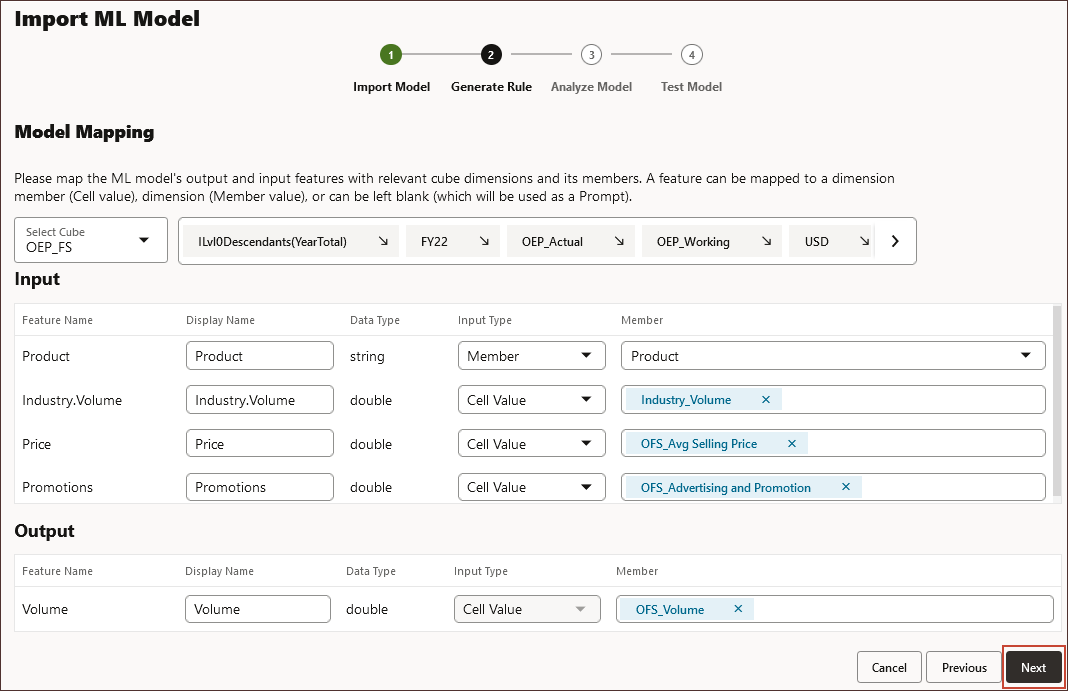
This step generates automatic Groovy rules that connect the ML model to the Planning application. Two Groovy rules are generated for each ML model definition: one rule to associate with a form or dashboard, which allows users to make predictions on demand, and another to generate large scale predictions in a scheduled job for bulk processing.

- Administrators deploy the ML model in a Planning application by associating the Groovy rule to relevant action menus, forms, or dashboards. Administrators can also create a job to run the Groovy rule in a batch process.
- Planners leverage ML-powered business rules in forms to generate predicted values, which are saved on the form. Planners can perform what-if analysis using the generated predictions, or modify predicted values on the form. Planners add value with their expertise and judgement, and then finalize the forecast.
- This is an iterative process. As planners make predictions based on the ML model, administrators can measure the performance of the model, and can work with data scientists to update or replace the ML model when needed. Then, administrators re-import and deploy the retrained ML model. When you re-import the retrained ML model, the Groovy rules are regenerated.
In this tutorial, you take the Groovy rule created from an imported ML Model, and add it to a form. Then you make predictions with the ML model in Planning.
What Do You Need?
An EPM Cloud Service instance allows you to deploy and use one of the supported business processes. To deploy another business process, you must request another EPM Enterprise Cloud Service instance or remove the current business process.
You must have:
- Service Administrator access to an EPM Enterprise Cloud Service instance.
- Upload and import this snapshot into your instance.
Activating Navigation Flows
In this section, you activate the ML Tutorial navigation flow so you can work with ML Models.
- On the home page, click Tools, then Navigation Flows.
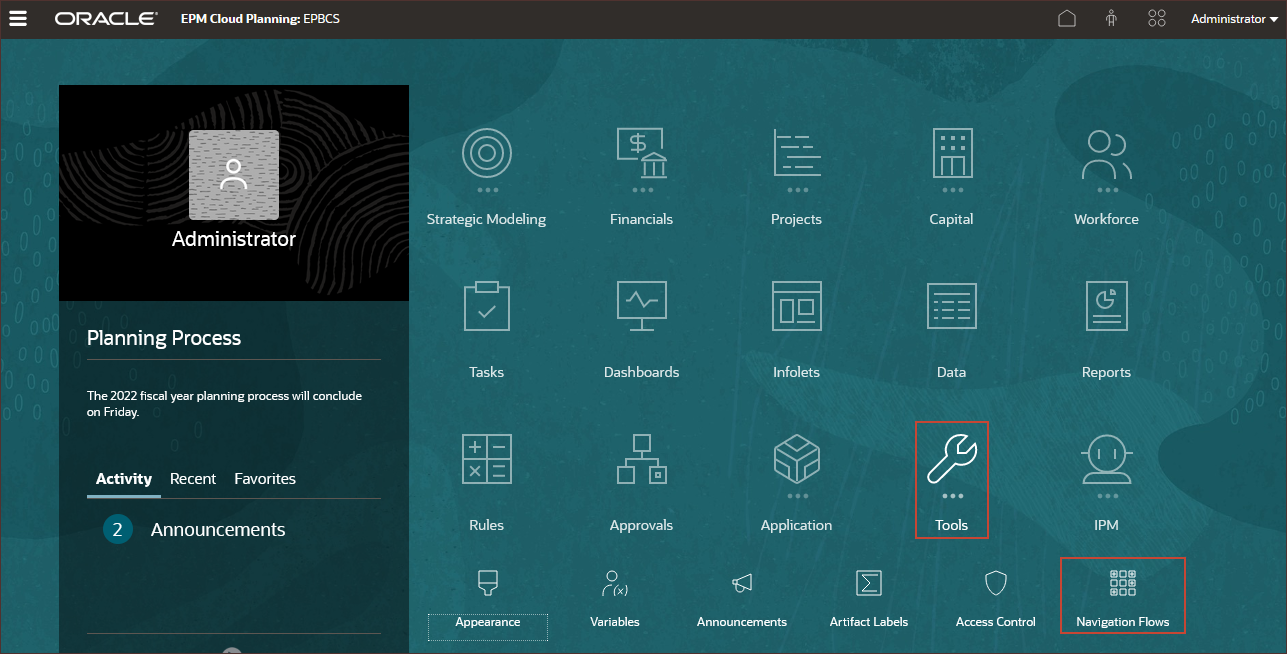
- For the ML Tutorial row, under Active, click Inactive.

The ML Tutorial navigation flow is activated, and the Default flow is inactivated.

- Click
 (Home).
(Home). - Click
 (Navigation Flow), and click ML Tutorial.
(Navigation Flow), and click ML Tutorial.

The ML Tutorial Navigation Flow is displayed.
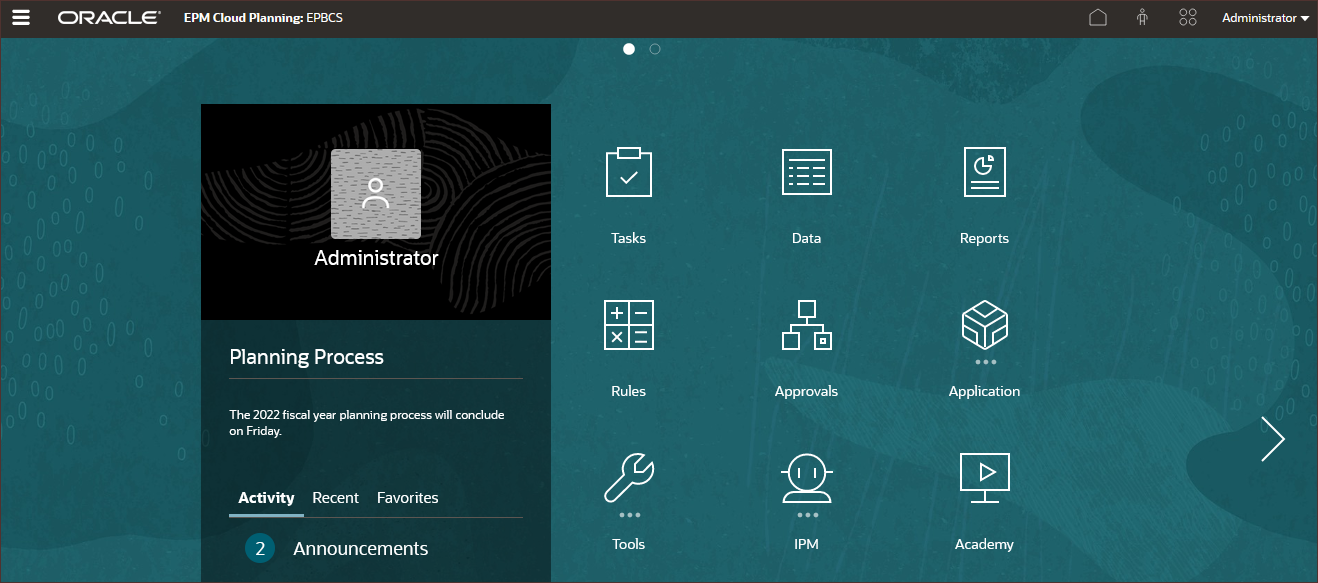
Assigning Values to User Variables
User Variables were added when the business process was created. User variables act as filters in forms, enabling planners to focus only on certain members. In this section, you set values for user variables.
- On the home page, click
 (Navigator), and under Tools, click User Preferences.
(Navigator), and under Tools, click User Preferences.

- Under Preferences, click User Variables.
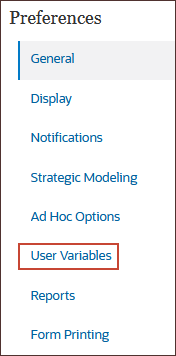
- For each variable, click its
 (Member Selector) to select a member as the variable's value:
(Member Selector) to select a member as the variable's value:
User Variable Member Infolet Entity NA Currency USD Entity Sales US - West Reporting Currency USD Scenario Actual Version Working Years FY22 Expense Account Total Marketing Expense Expense Drivers Marketing Expense Drivers Product Line 250-Servers - Verify your selections and click Save.
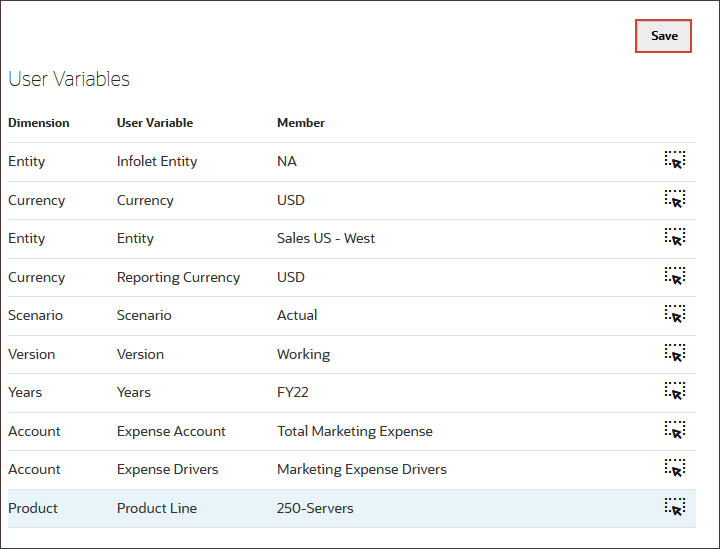
- At the information message, click OK.
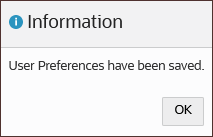
- Return to the home page. Click
 (Home).
(Home).
Reviewing Data for Key Drivers
In this section, you review key drivers for selling price, promotion spend, and industry volume.
- On the home page, click IPM then Volume Forecasting.
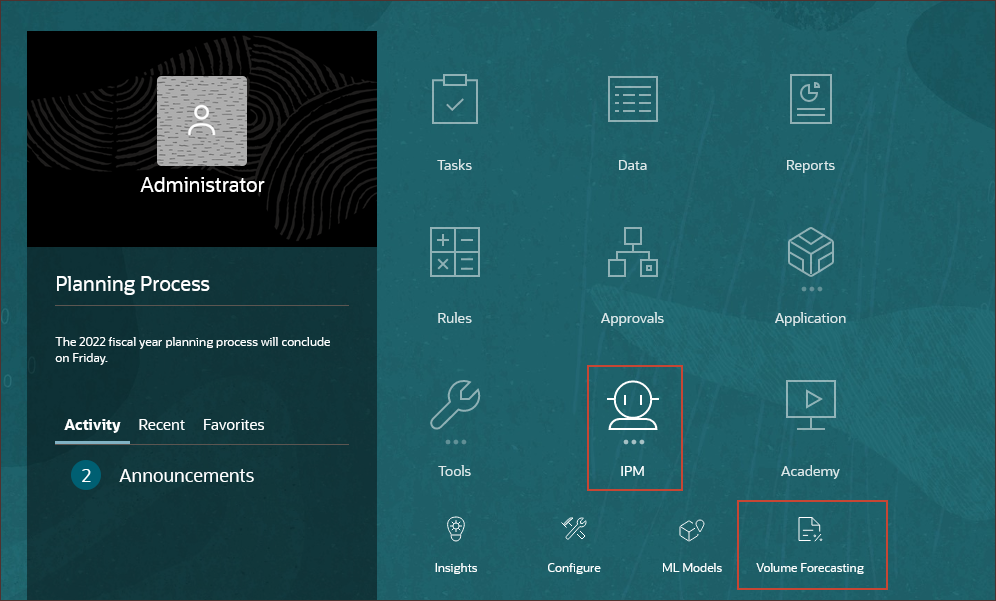
- On the bottom form for Drivers, from the drop-down list, select Average Selling Price and on the right side of the form, click
 (Go).
(Go).

The average selling price is one of the drivers used to predict volume.
- On the bottom form for Drivers, from the drop-down list, select Advertising and Promotion and on the right side of the form, click
 (Go).
(Go).

Advertising and Promotion data is used to predict volume.
- On the bottom form for Drivers, from the drop-down list, select Industry Volume and on the right side of the form, click
 (Go).
(Go).
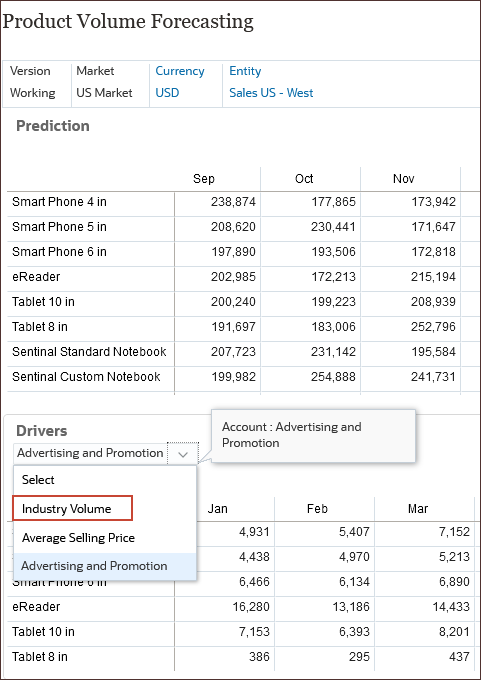
Industry Volume data is used to predict volume.
The Product Volume Forecasting dashboard is displayed. On the top form, product predictions are displayed. This includes volume by product category for all products. We plan to predict product volume for the first six months of FY22. On the bottom form, you can view product drivers.
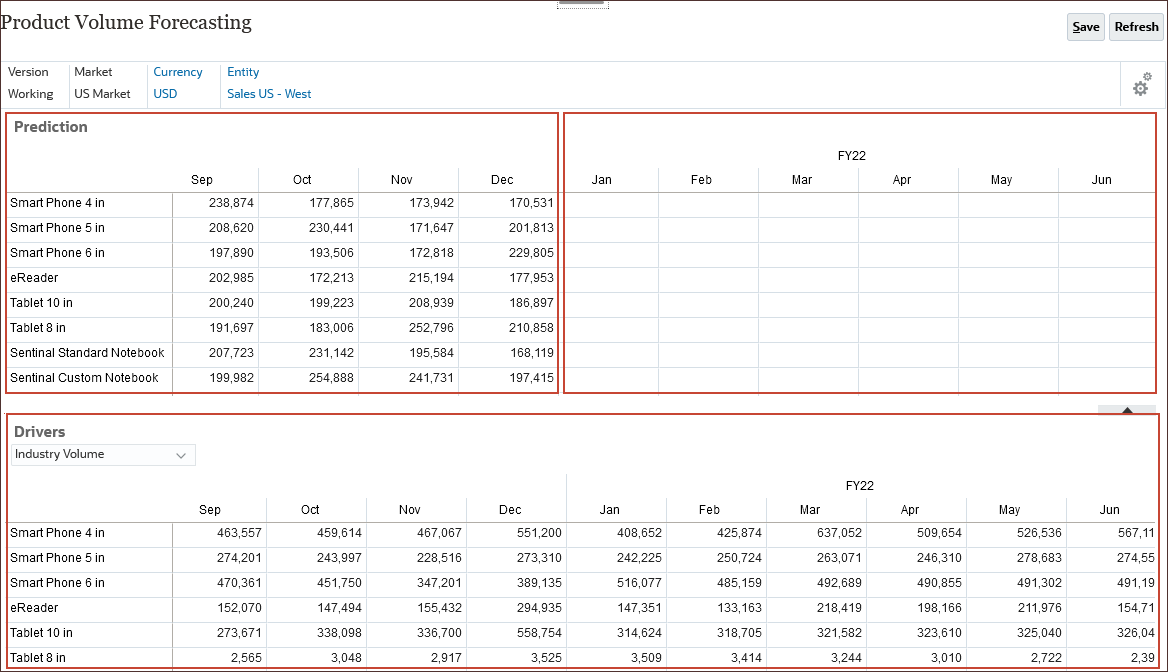
Deploying an ML Model to Planning
In this section, you deploy the ML Model to Planning by creating an action menu and selecting the Groovy rule to run from that action menu. You then add the action menu to a form. You can also run an ML Groovy rule as a batch job.
Creating an Action Menu
- Click
 (Navigator) and under Create and Manage, click Action Menus.
(Navigator) and under Create and Manage, click Action Menus.
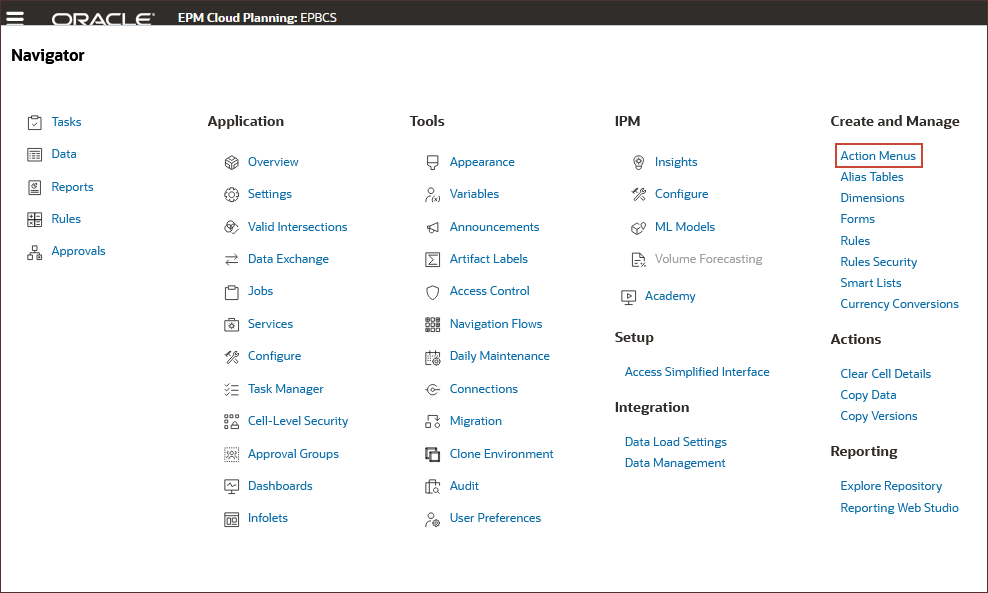
- Click
 (Create Menu).
(Create Menu). - Form Menu Name, enter Predict Volume with ML, and click OK.

- Ensure that Predict Volume with ML is selected, and click
 (Edit).
(Edit). - Click
 (Add Child).
(Add Child).
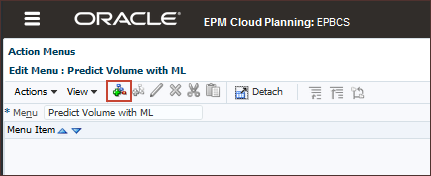
- Enter or select the following information, and click Save.
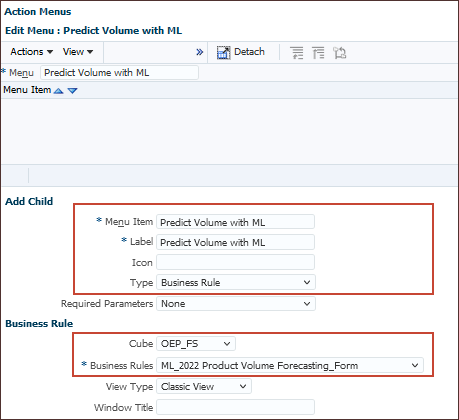
- At the Information message, click OK.

Adding an Action Menu to a Form
- Click
 (Navigator) and under Create and Manage, click Forms.
(Navigator) and under Create and Manage, click Forms.
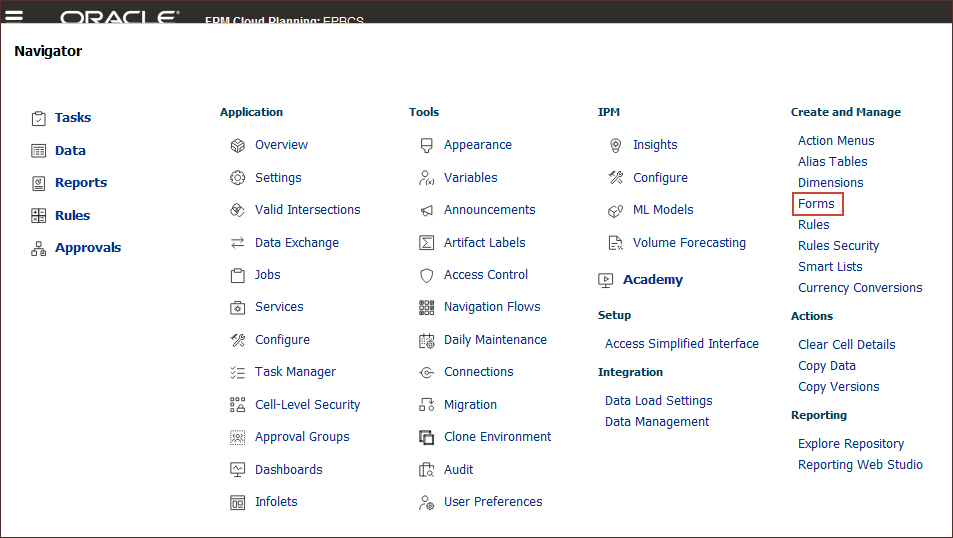
- Under Folders, expand Library, and Financials and then select Financials - Planbook - Revenue.
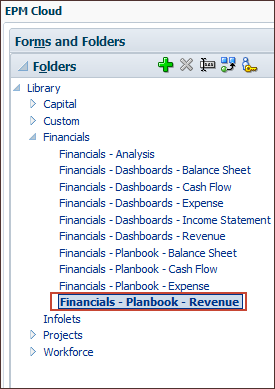
- In the Content panel on the right, select PMML Forecast V2 Inputs, and click
 (Edit).
(Edit).

- Click the Other Options tab.

- In Context Menus, for Available Menus, locate and select Predict Volume with ML, and click
 (Move Selected Items to Selected Menus).
(Move Selected Items to Selected Menus).

- To save and close the form, click Finish.
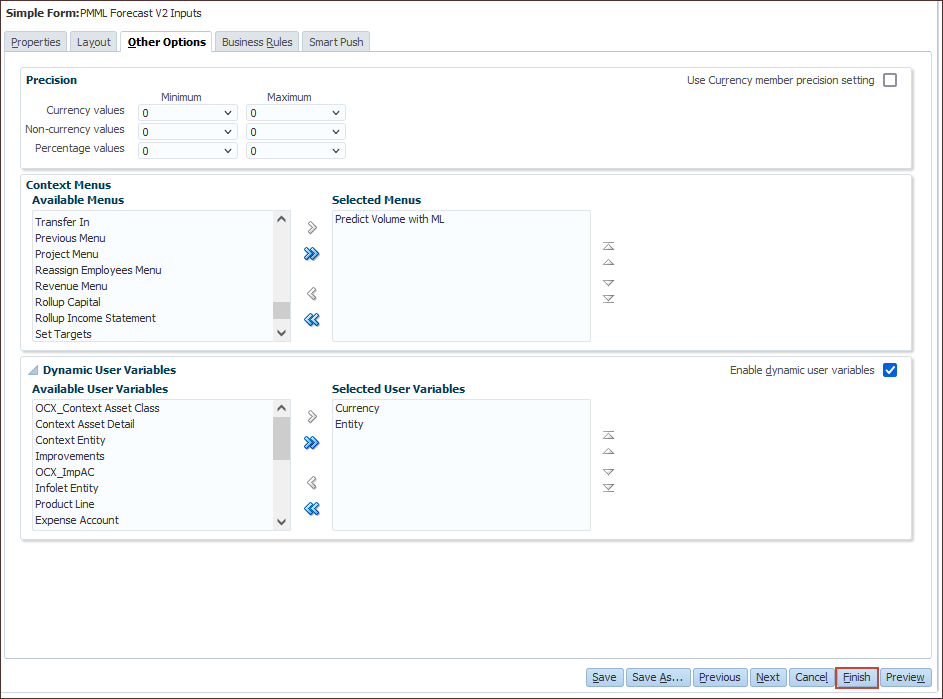
- Close Form and Ad Hoc Grid Management by clicking X in the top right corner.
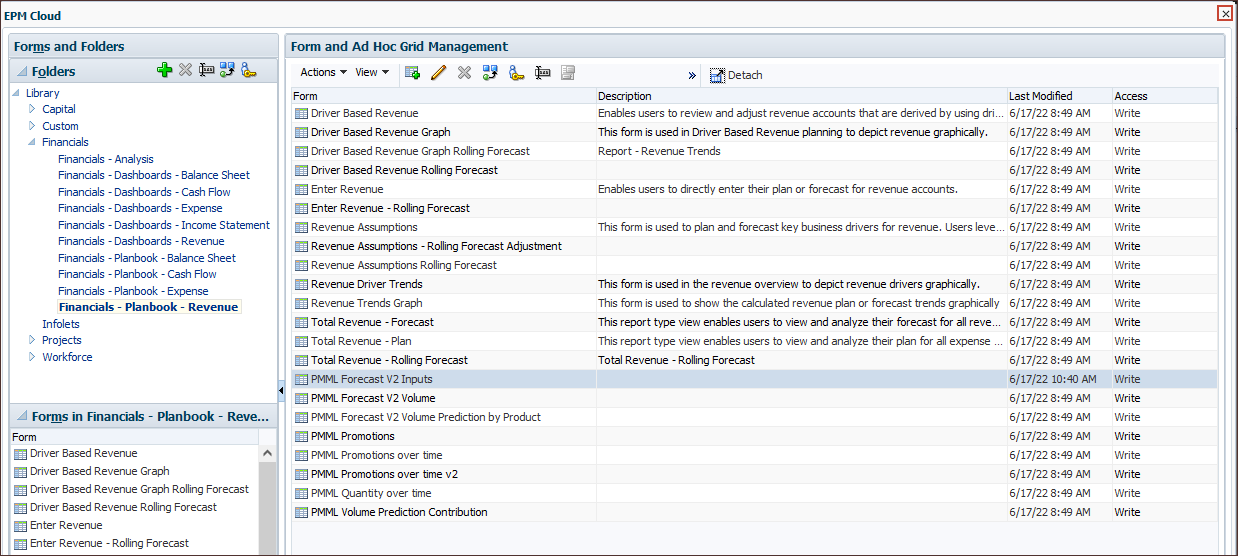
Running Predictions
In this section you predict volume for the next six months based on key drivers. This approach differs from classic predictive planning which typically uses one measure as a basis for the prediction. Instead, Machine Learning uses a multi-variate approach where you predict product volume by using multiple contributing input drivers. On the Product Volume Forecasting dashboard, you use the drivers on the bottom form to predict product volume on the top form. Product volume predictions are made based on industry volume, average selling price and advertising and promotion.
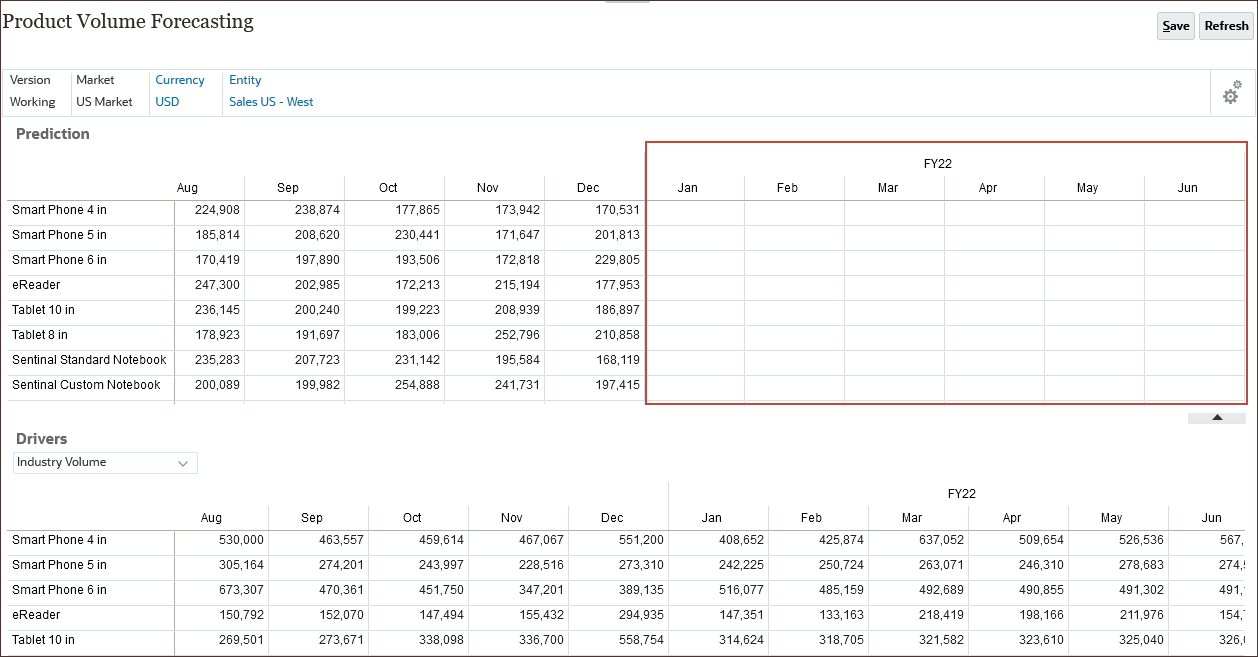
- Click
 (Navigator) and under IPM, click Volume Forecasting.
(Navigator) and under IPM, click Volume Forecasting.

- In the top form, scroll right to see January through June of FY22.

The ML Model will be used to predict the first six months of FY22.
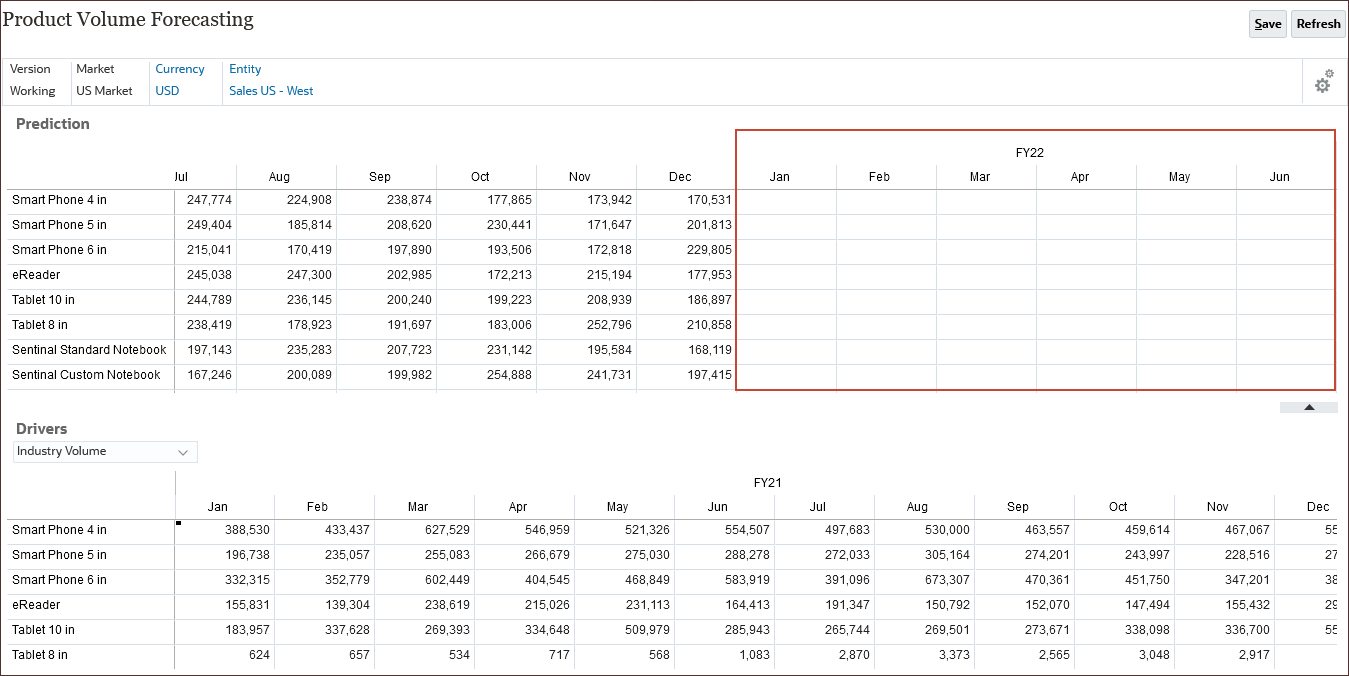
- On the Drivers form, right-click a cell such as at the intersection of Smart Phone 4 in and Jun FY21, and select Predict Volume with ML.
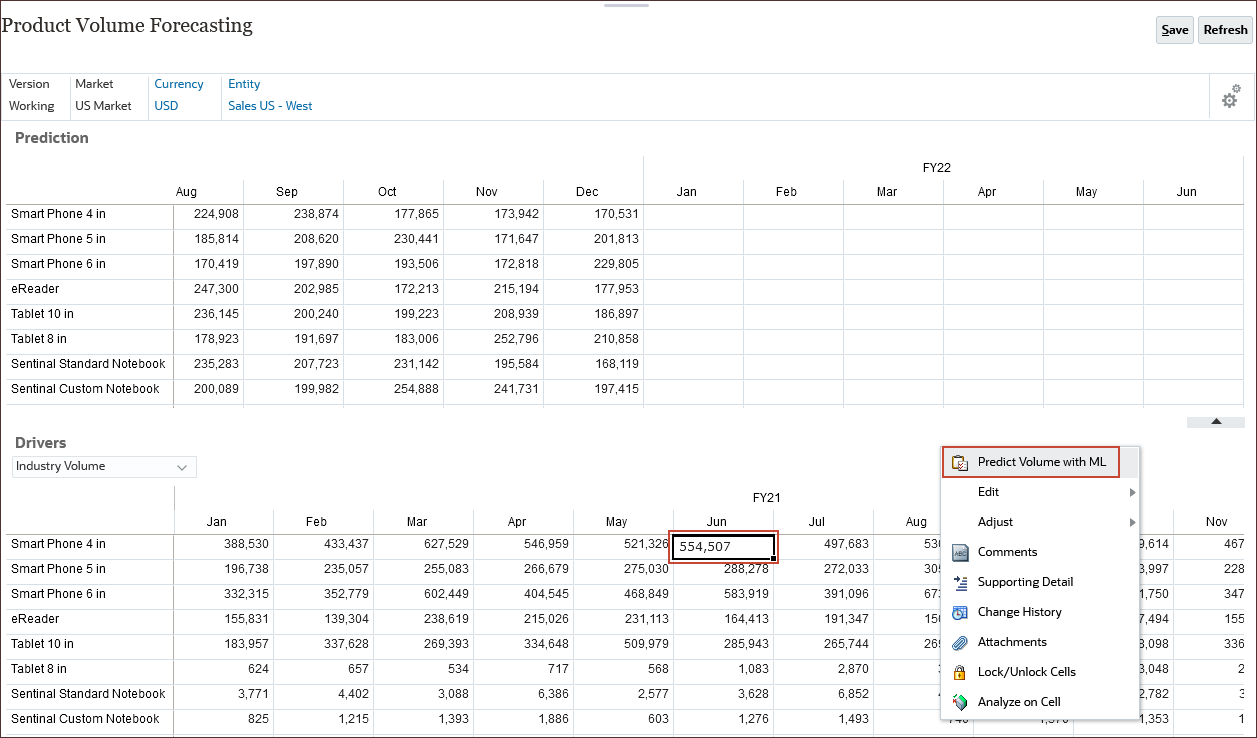
This triggers the prediction rule that in turn runs the rule using the ML model that was imported and deployed in the planning application.
The rule picks the input drivers and gets the output which is populated back into the planning form. Planners can run through various what-if scenarios to adjust their forecasts and plans, or adjust the predicted values.
Note:
The rule runs in the context of the form, predicting values only for cells on the form. Security is honored so that planners see predictions only for intersections to which they have access.The predictions are displayed in the top form.
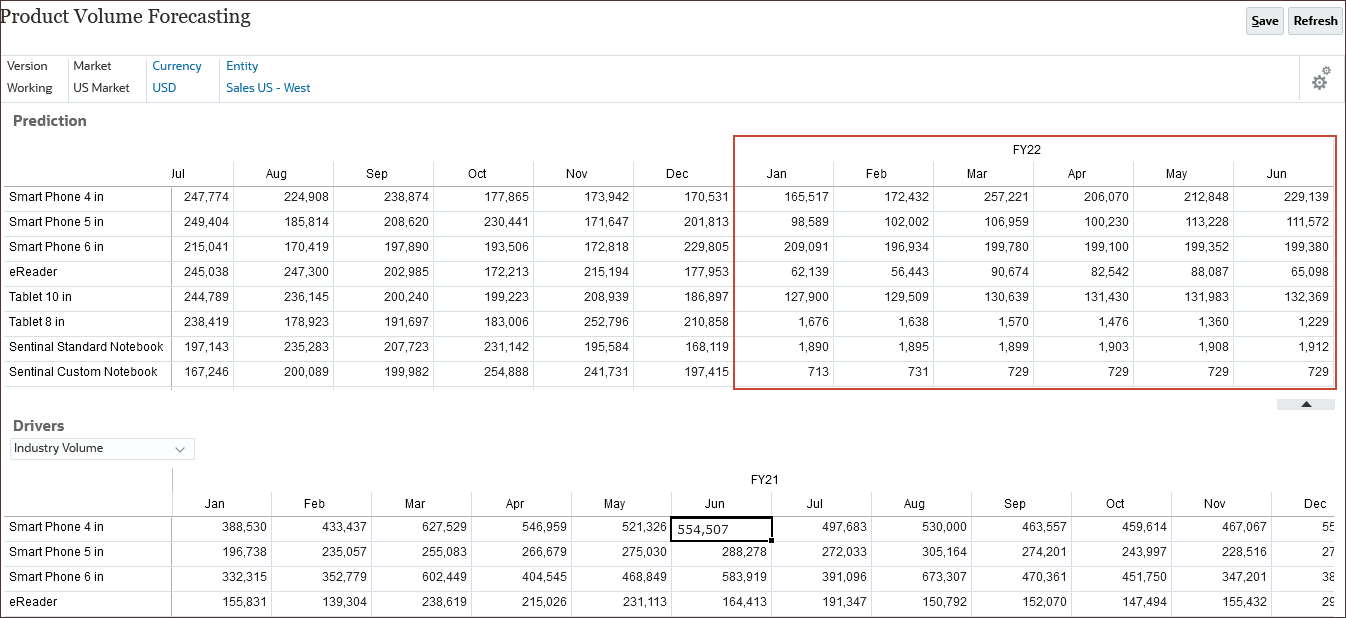
Note:
As planners make predictions based on the ML model, administrators can measure the performance of the model, and can work with data scientists to update or replace the ML model when needed. Then, administrators re-import and deploy the retrained ML model. When you re-import the retrained ML model, the Groovy rules are regenerated.
Learn More
Making Predictions with ML Models
F56996-01
June 2022
Copyright © 2022, Oracle and/or its affiliates.
This tutorial shows you how to make predictions with ML models in EPM Cloud.
This software and related documentation are provided under a license agreement containing restrictions on use and disclosure and are protected by intellectual property laws. Except as expressly permitted in your license agreement or allowed by law, you may not use, copy, reproduce, translate, broadcast, modify, license, transmit, distribute, exhibit, perform, publish, or display any part, in any form, or by any means. Reverse engineering, disassembly, or decompilation of this software, unless required by law for interoperability, is prohibited.
If this is software or related documentation that is delivered to the U.S. Government or anyone licensing it on behalf of the U.S. Government, then the following notice is applicable:
U.S. GOVERNMENT END USERS: Oracle programs (including any operating system, integrated software, any programs embedded, installed or activated on delivered hardware, and modifications of such programs) and Oracle computer documentation or other Oracle data delivered to or accessed by U.S. Government end users are "commercial computer software" or "commercial computer software documentation" pursuant to the applicable Federal Acquisition Regulation and agency-specific supplemental regulations. As such, the use, reproduction, duplication, release, display, disclosure, modification, preparation of derivative works, and/or adaptation of i) Oracle programs (including any operating system, integrated software, any programs embedded, installed or activated on delivered hardware, and modifications of such programs), ii) Oracle computer documentation and/or iii) other Oracle data, is subject to the rights and limitations specified in the license contained in the applicable contract. The terms governing the U.S. Government's use of Oracle cloud services are defined by the applicable contract for such services. No other rights are granted to the U.S. Government.
This software or hardware is developed for general use in a variety of information management applications. It is not developed or intended for use in any inherently dangerous applications, including applications that may create a risk of personal injury. If you use this software or hardware in dangerous applications, then you shall be responsible to take all appropriate fail-safe, backup, redundancy, and other measures to ensure its safe use. Oracle Corporation and its affiliates disclaim any liability for any damages caused by use of this software or hardware in dangerous applications.
Oracle and Java are registered trademarks of Oracle and/or its affiliates. Other names may be trademarks of their respective owners.
Intel and Intel Inside are trademarks or registered trademarks of Intel Corporation. All SPARC trademarks are used under license and are trademarks or registered trademarks of SPARC International, Inc. AMD, Epyc, and the AMD logo are trademarks or registered trademarks of Advanced Micro Devices. UNIX is a registered trademark of The Open Group.
This software or hardware and documentation may provide access to or information about content, products, and services from third parties. Oracle Corporation and its affiliates are not responsible for and expressly disclaim all warranties of any kind with respect to third-party content, products, and services unless otherwise set forth in an applicable agreement between you and Oracle. Oracle Corporation and its affiliates will not be responsible for any loss, costs, or damages incurred due to your access to or use of third-party content, products, or services, except as set forth in an applicable agreement between you and Oracle.